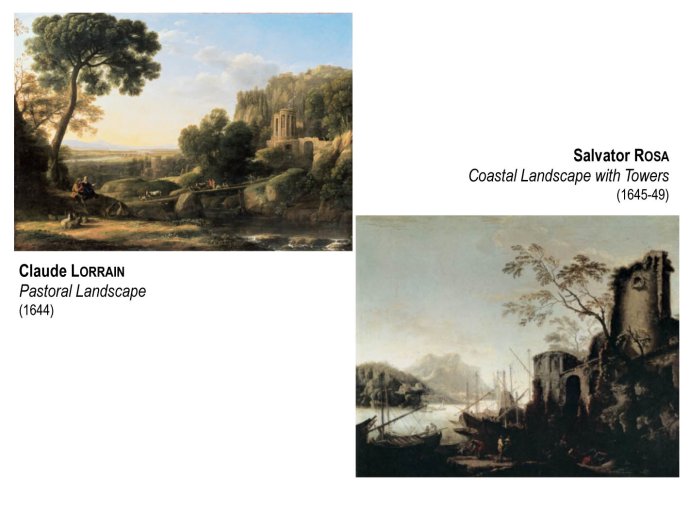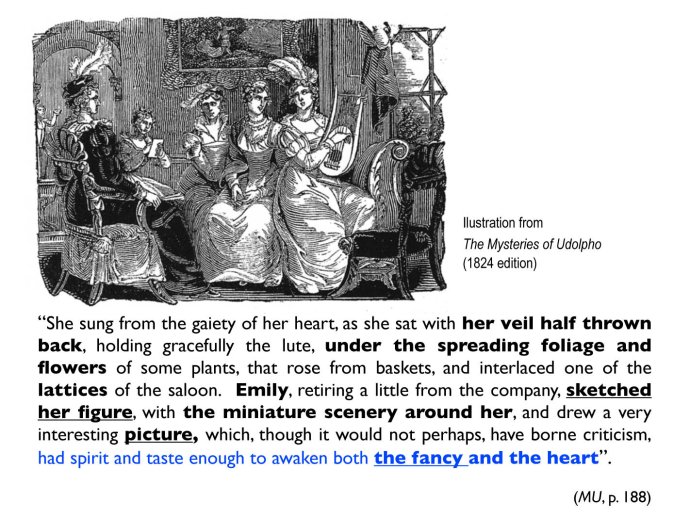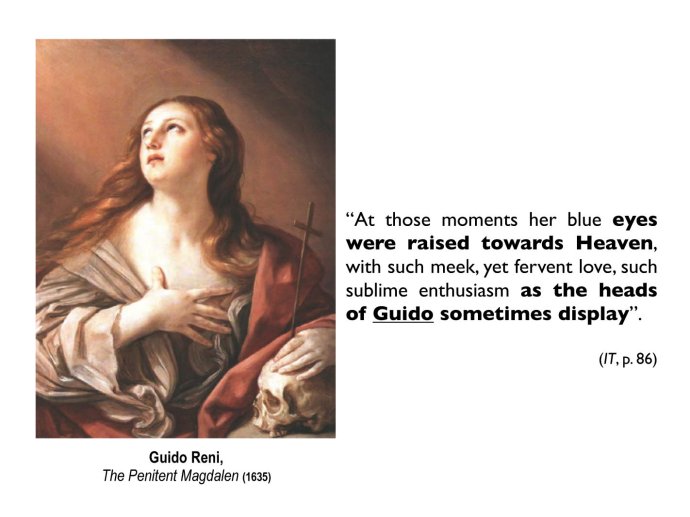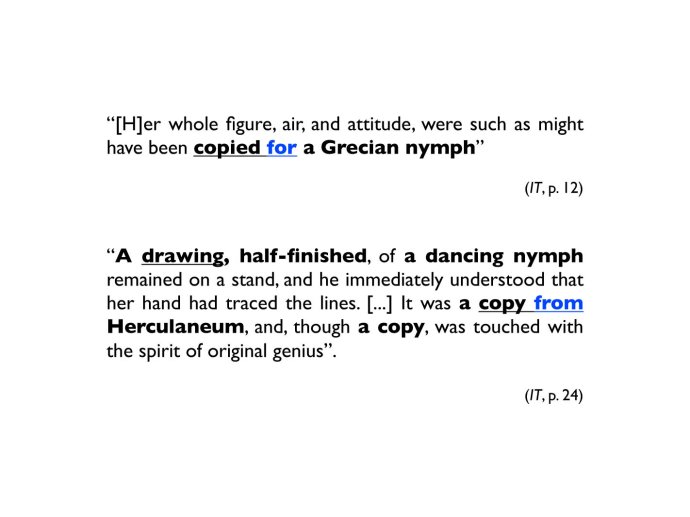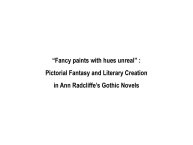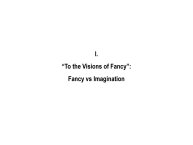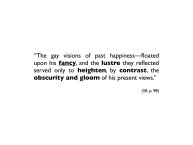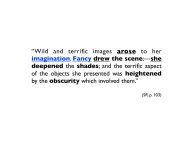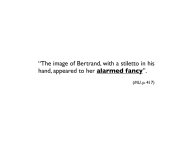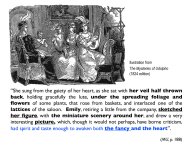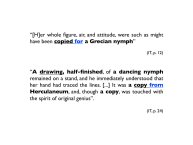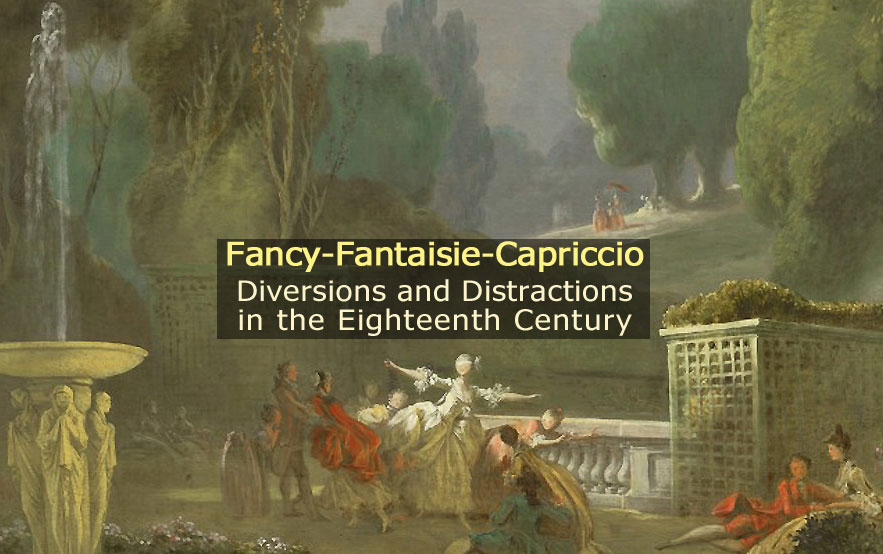Notice
‘Fancy Paints with Hues Unreal’ : Pictorial Fantasy and Literary Creation in Ann Radcliffe’s Gothic Novel / Alice Labourg
- document 1 document 2 document 3
- niveau 1 niveau 2 niveau 3
Descriptif
‘Fancy Paints with Hues Unreal’ : Pictorial Fantasy and Literary Creation in Ann Radcliffe’s Gothic Novel / Alice Labourg, in colloque international organisé, sous la responsabilité scientifique de Muriel Adrien, Melissa Percival et Axel Hémery, par l’Université Toulouse Jean Jaurès et l’Université d’Exeter. Toulouse, Musée Paul-Dupuy, 3-4 décembre 2015.
Before Coleridge praised imagination over fancy, Ann Radcliffe, following the empiricist conceptions of her times, celebrated the versatile powers of fancy in her Gothic novels. Fancy is indeed presented as a positive and liberating force of creation as opposed to the erring delusions of imagination that maintain the heroine in a state of superstitious dread. Phenomenologically conceived as a painter who literally paints pictures in the mind, fancy sustains Radcliffe’s pictorial writing in her creation of picturesque tableaux the reader is asked to see as true “pictures” in words. Drawing from extradiegetical visual models and merging the beautiful with the picturesque and the sublime, a form of pictorial fantasy conjures up the emblematic Gothic décor, in which Piranesian-like architectural capricci fuse with Claudian twilight effects and Salvatoresque mountainous compositions, while characters tend to be frozen in dramatic picture-like poses. Fancy is likewise the power that the heroine appeals to in her own creation of intradiegetical works of art, landscape drawings and poems that provide metatextual images of the writing process itself. The workings of fancy are actually the central driving forces in the creation of the Radcliffean Gothic, a form of “pictorial fantastic”, as Maurice Lévy first suggested, based on the “animation of painted pictures”. The technique of the explained supernatural, which became one of Radcliffe’s trademarks, can thus be regarded not so much as the triumph of reason as the triumph of fancy over imagination.
Thème
Documentation
Références documentaires
LABOURG, Alice (2013). Peinture et écriture : l'imaginaire pictural dans les romans gothiques d'Ann Radcliffe. Thèse de doctorat en Études anglophones, Université d'Aix-Marseille (France).
OGÉE, Frédéric (1996). Les songes d'Adeline : quelques remarques sur les lieux du gothique dans « The Romance of the Forest » d'Ann Radcliffe, Caliban, 33, février 1996, 29-42.
RADCLIFFE, Ann (1794). The Mysteries of Udolpho. Londres, G. and J. Robinson. (rééd. Oxford University Press, 2008, 736 p.). [En ligne : http://www.gutenberg.org/ebooks/3268]
RADCLIFFE, Ann [1794] (2001). Les Mystères d'Udolphe. Traduit de l'anglais par Victorine de Chastenay et révisé par Maurice Lévy. Paris, Éditions Gallimard, coll. Folio classique, 912 p. [En ligne : http://www.gutenberg.org/ebooks/43652].
RADCLIFFE, Ann (1790). A Sicilian Romance. (rééd. Oxford University Press, 2008, 256 p.). [En ligne : http://www.gutenberg.org/ebooks/7371].
> Voir aussi la bibliographie à télécharger dans l'onglet "Documents".
Dans la même collection
-
Modelling for the Fancy Picture: fact, fiction and fantasy / Martin Postle
PostleMartinModelling for the Fancy Picture: fact, fiction and fantasy / Martin Postle, in colloque international "Fancy‒Fantaisie‒Capriccio. Diversions and Distractions in the Eighteenth Century" organisé, sous
-
Fancying Nature: the posterity of Joseph Addison’s ‘Pleasures’ in English Enlightenment culture / F…
OgéeFrédéricFancying Nature: the posterity of Joseph Addison’s ‘Pleasures’ in English Enlightenment culture / Frédéric Ogée, in colloque international "Fancy‒Fantaisie‒Capriccio. Diversions and Distractions in
-
The many peopled wall: Fancy Pictures and Annual Exhibitions in Eighteenth-Century London / John Chu
ChuJohnThe many peopled wall: Fancy Pictures and Annual Exhibitions in Eighteenth-Century London / John Chu, in colloque international organisé, sous la responsabilité scientifique de Muriel Adrien, Melissa
-
British Capricci: from the Picturesque to the Sublime / Hélène Ibata
Pharabod-IbataHélèneBritish Capricci: from the Picturesque to the Sublime / Hélène Ibata, in colloque international organisé, sous la responsabilité scientifique de Muriel Adrien, Melissa Percival et Axel Hémery, par l
-
Le coq et le léopard. Portrait et petite histoire des collections de peintures britanniques du musé…
FaroultGuillaumeLe coq et le léopard. Portrait et petite histoire des collections de peintures britanniques du musée du Louvre / Guillaume Faroult, in colloque international organisé, sous la responsabilité
-
Figures de fantaisie de Jean-Baptiste Santerre et limites des cadres génériques d’interprétation / …
Faure-CarricaburuEmmanuelFigures de fantaisie de Jean-Baptiste Santerre et limites des cadres génériques d’interprétation / Emmanuel Faure-Carricaburu, in colloque international organisé, sous la responsabilité scientifique
-
La production gravée parisienne au cœur de l’invention d’un genre ? Les «fantaisies» de Poilly et C…
GuillouetChristopheLa production gravée parisienne au cœur de L’invention d’un genre ? Les «fantaisies» de Poilly et Courtin (1710–1728) / Christophe Guillouet, in colloque international organisé, sous la
-
‘As Whimsical and Chimearical as their Forms Are’ : Ornamental and Fanciful Motives in English Draw…
PavotBénédicte‘As Whimsical and Chimearical as their Forms Are’ : Ornamental and Fanciful Motives in English Drawing Books / Bénédicte Miyamoto, in colloque international organisé, sous la responsabilité
-
De la fantaisie des éventails aux éventails de fantaisie / Pierre-Henri Biger
BigerPierre-HenriDe la fantaisie des éventails aux éventails de fantaisie / Pierre-Henri Biger, in colloque international organisé, sous la responsabilité scientifique de Muriel Adrien, Melissa Percival et Axel
-
"A Butterfly Supporting an Elephant": Chinoiserie in Eighteenth-Century England, or "the Luxuriance…
Alayrac-FieldingVanessa"A Butterfly Supporting an Elephant": Chinoiserie in Eighteenth-Century England, or "the Luxuriance of Fancy" / Vanessa Alayrac, in colloque international organisé, sous la responsabilité scientifique
-
Réminiscences vénitiennes et hybridité culturelle dans les vues et capricci anglais de Canaletto / …
CervantesXavierRéminiscences vénitiennes et hybridité culturelle dans les vues et capricci anglais de Canaletto / Xavier Cervantes, in colloque international organisé, sous la responsabilité scientifique de Muriel
-
Du cabinet privé à la villa suburbaine : caprices et fantaisies artistiques dans la capitale des Lu…
Fernández AlmogueraAdriánDu cabinet privé à la villa suburbaine : caprices et fantaisies artistiques dans la capitale des Lumières espagnoles / Adrián Fernández Almoguera, in colloque international organisé, sous la











